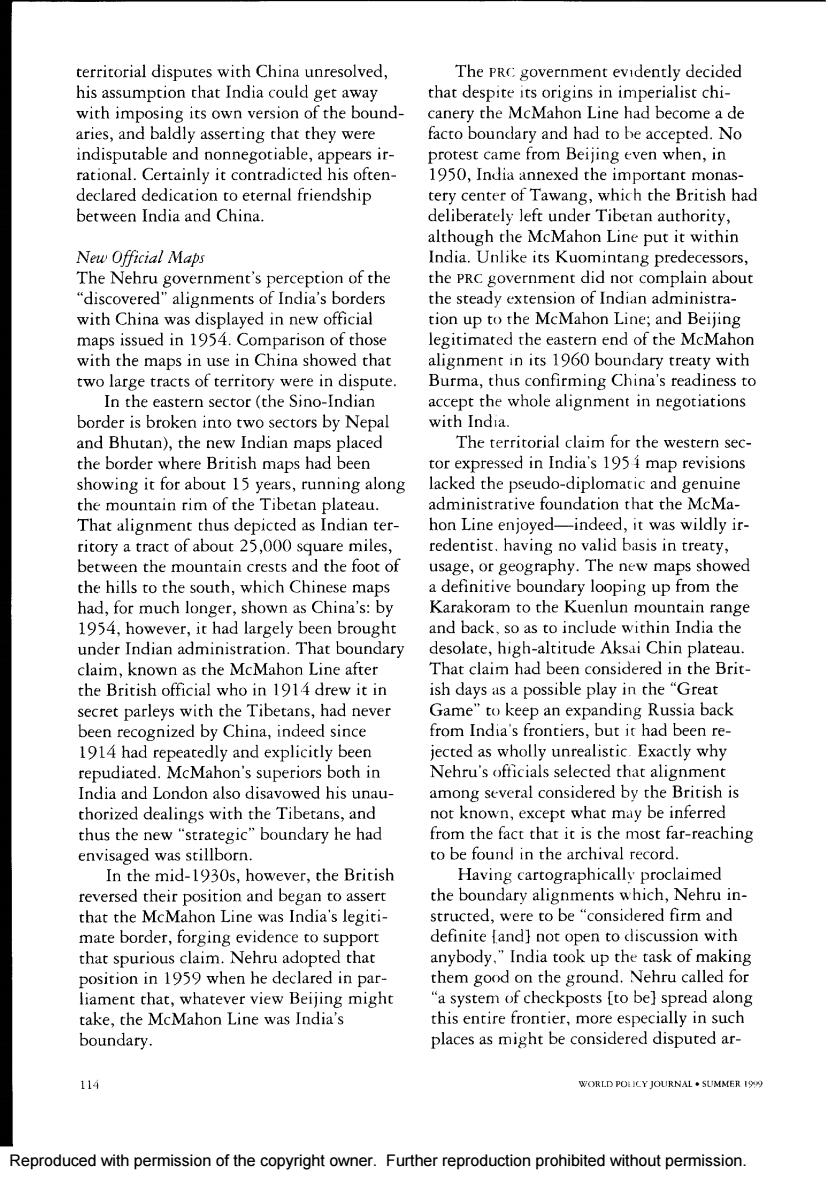正在加载图片...

territorial disputes with China unresolved, The PRC government evidently decided his assumption chat India could get away that despite its origins in imperialist chi- with imposing its own version of the bound- canery the McMahon Line had become a de aries,and baldly asserting that they were facto boundary and had to be accepted.No indisputable and nonnegotiable,appears ir- protest came from Beijing even when,in rational.Certainly it contradicted his often- 1950,India annexed the important monas- declared dedication to eternal friendship tery center of Tawang,which the British had between India and China. deliberately left under Tibetan authority, although the McMahon Line put it within New Official Maps India.Unlike its Kuomintang predecessors, The Nehru government's perception of the the PRC government did not complain about "discovered"alignments of India's borders the steady extension of Indian administra- with China was displayed in new official tion up to the McMahon Line;and Beijing maps issued in 1954.Comparison of those legitimated the eastern end of the McMahon with the maps in use in China showed that alignment in its 1960 boundary treaty with two large tracts of territory were in dispute. Burma,thus confirming China's readiness to In the eastern sector(the Sino-Indian accept the whole alignment in negotiations border is broken into two sectors by Nepal with India. and Bhutan),the new Indian maps placed The territorial claim for the western sec- the border where British maps had been tor expressed in India's 195 i map revisions showing it for about 15 years,running along lacked the pseudo-diplomatic and genuine the mountain rim of the Tibetan plateau. administrative foundation that the McMa- That alignment thus depicted as Indian ter- hon Line enjoyed-indeed,it was wildly ir- ritory a tract of about 25,000 square miles, redentist.having no valid basis in treaty, between the mountain crests and the foot of usage,or geography.The new maps showed the hills to the south,which Chinese maps a definitive boundary looping up from the had,for much longer,shown as China's:by Karakoram to the Kuenlun mountain range 1954,however,it had largely been brought and back,so as to include within India the under Indian administration.That boundary desolate,high-altitude Aksai Chin plateau. claim,known as the McMahon Line after That claim had been considered in the Brit- the British official who in 1914 drew it in ish days as a possible play in the "Great secret parleys with the Tibetans,had never Game"to keep an expanding Russia back been recognized by China,indeed since from India's frontiers,but it had been re- 1914 had repeatedly and explicitly been jected as wholly unrealistic.Exactly why repudiated.McMahon's superiors both in Nehru's officials selected that alignment India and London also disavowed his unau- among several considered by the British is thorized dealings with the Tibetans,and not known,except what may be inferred thus the new "strategic"boundary he had from the fact that it is the most far-reaching envisaged was stillborn. to be found in the archival record. In the mid-1930s,however,the British Having cartographically proclaimed reversed their position and began to assert the boundary alignments which,Nehru in- that the McMahon Line was India's legiti- structed,were to be "considered firm and mate border,forging evidence to support definite [and]not open to discussion with that spurious claim.Nehru adopted that anybody,"India took up the task of making position in 1959 when he declared in par- them good on the ground.Nehru called for liament chat,whatever view Beijing might "a system of checkposts [to be]spread along take,the McMahon Line was India's this entire frontier,more especially in such boundary places as might be considered disputed ar- 114 WORLD POLICY JOURNAL.SUMMER 1999 Reproduced with permission of the copyright owner.Further reproduction prohibited without permission.Reproduced with permission of the copyright owner. Further reproduction prohibited without permission